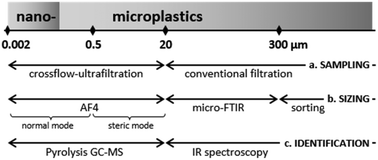Closing the gap between small and smaller: towards a framework to analyse nano- and microplastics in aqueous environmental samples†
Abstract
Measuring concentrations and sizes of micro- and nanoplastics in the environment is essential to assess the risks plastic particles could pose. Microplastics have been detected globally in a variety of aquatic ecosystems. The determination of nanoplastics, however, is lagging behind due to higher methodological challenges. Here, we propose a framework that can consistently determine a broad spectrum of plastic particle sizes in aquatic environmental samples. Analytical evidence is provided as proof of principle. FTIR microscopy is applied to detect microplastics. Nanoplastics are studied using field-flow-fractionation and pyrolysis GC-MS that gives information on the particle sizes and polymer types. Pyrolysis GC-MS is shown to be promising for the detection of nanoplastics in environmental samples as a mass of approximately 100 ng is required to identify polystyrene. Pre-concentrating nanoplastics by crossflow ultrafiltration enables polystyrene to be identified when the original concentration in an aqueous sample is >20 μg L−1. Finally, we present an approach to estimate polymer masses based on the two-dimensional microplastic shapes recorded during the analysis with FTIR microscopy. Our suite of techniques demonstrates that analysis of the entire size spectrum of plastic debris is feasible.

- This article is part of the themed collections: Best Papers 2018 – Environmental Science: Nano and Best Papers from 2018 in the Environmental Science Family of Journals


 Please wait while we load your content...
Please wait while we load your content...